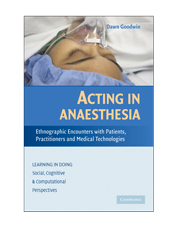Book contents
- Frontmatter
- Contents
- Series Foreword
- Acknowledgements
- Acting in Anaesthesia: Ethnographic Encounters with Patients, Practitioners and Medical Technologies
- 1 Understanding Anaesthesia: Theory and Practice
- 2 Refashioning Bodies, Reshaping Agency
- 3 Accounting for Incoherent Bodies
- 4 Teamwork, Participation and Boundaries
- 5 Embodied Knowledge: Coordinating Spaces, Bodies and Tools
- 6 Recognising Agency, Legitimating Participation and Acting Accountably in Anaesthesia
- References
- Index
- Titles in the series
5 - Embodied Knowledge: Coordinating Spaces, Bodies and Tools
Published online by Cambridge University Press: 20 August 2009
- Frontmatter
- Contents
- Series Foreword
- Acknowledgements
- Acting in Anaesthesia: Ethnographic Encounters with Patients, Practitioners and Medical Technologies
- 1 Understanding Anaesthesia: Theory and Practice
- 2 Refashioning Bodies, Reshaping Agency
- 3 Accounting for Incoherent Bodies
- 4 Teamwork, Participation and Boundaries
- 5 Embodied Knowledge: Coordinating Spaces, Bodies and Tools
- 6 Recognising Agency, Legitimating Participation and Acting Accountably in Anaesthesia
- References
- Index
- Titles in the series
Summary
When practice proceeds smoothly, without problems, the constitution of the place of work is largely taken for granted by participants, treated as a transparent background for the work at hand (Suchman, 1996). Likewise, once mastery is gained over tools and instruments, those devices no longer hold a focal awareness for participants (Gherardi, 2000). However, research in areas such as airline operations rooms (Goodwin and Goodwin, 1996; Suchman, 1996), underground train drivers (Heath et al., 1999) and telesales work (Whalen et al., 2002) have shown how the careful ordering of materials and people affords certain perspectives which are integral to the proficient accomplishment of practice. These studies, however, do not elaborate on what happens when the spatial arrangements are disrupted. What consequences follow from the upset of the regular coordination of materials, people and positionings? In this chapter, I examine the relationship between the spatial dimensions of the workplace, the arrangement of material resources and the development of embodied knowledge. I explore how such knowledges feature within a team of differentially qualified and experienced health care practitioners. I have selected examples from anaesthetic practice in which the seamless flow of routine work is sharply interrupted by disturbances to the usual configuration of patients, practitioners, and tools. In these situations, the workplace and the equipment within it is far from a transparent background but plays a prominent role in shaping practices and knowledges.
- Type
- Chapter
- Information
- Acting in AnaesthesiaEthnographic Encounters with Patients, Practitioners and Medical Technologies, pp. 139 - 166Publisher: Cambridge University PressPrint publication year: 2009



